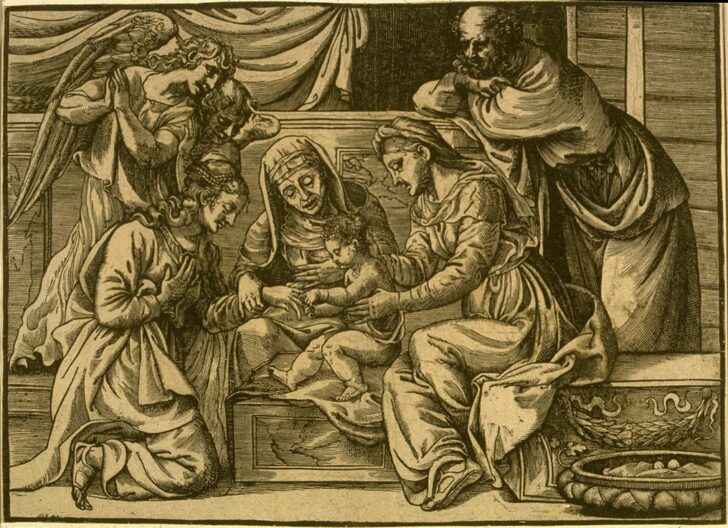The Mystic Marriage of St. Catherine
Niccolò Boldrini

Description
This woodcut was executed at about the time that Titian turned from making designs specifically meant for that medium to using woodcuts to copy his paintings and make his compositions better known. This image is based on a lunette-shaped painting, now lost, that once hung over a wall tomb in the church of Saints Giovanni and Paolo in Venice. The woodcut does not exactly reproduce Titian's painting; the side figures of two angels and Saint Joseph in the print replaced two Domenican saints who flanked the central scene of Saint Catherine of Alexandria receiving a ring from the Christ Child in the painting. Titian seems to have given Boldrini drawings in different styles to work into a composition. The lateral figures are more lively, twisting and turning in space, wheras the central figures, which were in the original painting, are more static, shown in profile or frontally.
Exhibition label text for "Venice, Traditions Transformed," September 21, 1996 - January 12, 1997 by Annette Dixon and Monika Schmitter.
Niccolò Boldrini was one of the woodcutters that the Venetian painter Titian employed to reproduce his paintings in the medium of woodcut. To make a woodcut, a carver uses a knife or a gouge to cut away wood from a wood block, leaving raised areas that will print the lines of the image. Boldrini’s woodcut is based on a lunette-shaped painting, no longer extant, which once hung over a wall tomb in the church of Saints Giovanni and Paolo in Venice. The woodcut does not exactly reproduce Titian’s painting: it features two angels and Saint Joseph flanking the central scene of Saint Catherine of Alexandra receiving a ring from the Christ Child, instead of the two Dominican saints that appeared in the original. Titian and Boldrini worked together to produce this work, with Titian supplying drawings to the woodcutter. Titian seems to have given Boldrini drawings in different styles to work into a composition. The new figures, twisting and turning in space, present a livelier appearance than those in the center, which are more static, shown in profile or from the front.
Gallery label text, collections gallery, by Curator Annette Dixon, February, 2000.
Usage Rights:
If you are interested in using an image for a publication, please visit https://umma.umich.edu/request-image/ for more information and to fill out the online Image Rights and Reproductions Request Form.